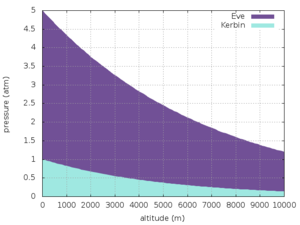Difference between revisions of "Eve"
m (changed gravitional parameters to SI and adjusted mass to standard notation) |
m (Corrected reason for non-functioning jet engines) |
||
| Line 61: | Line 61: | ||
From within Eve's atmosphere, the sky appears indigo-blue during nighttime. During dawn and dusk, the sky is green. The atmosphere is probably composed of iodine given its purple coloration. | From within Eve's atmosphere, the sky appears indigo-blue during nighttime. During dawn and dusk, the sky is green. The atmosphere is probably composed of iodine given its purple coloration. | ||
| − | Jet engines function in Eve's atmosphere, but do not | + | Jet engines function in Eve's atmosphere, to the extent of making noise and consuming fuel, but do not produce useful thrust, due to lack of oxygen to burn. |
|} | |} | ||
Revision as of 03:56, 10 October 2012
Eve is the second planet from Kerbol, and the second largest body orbiting it. It is purple in appearance. It has one small asteroid called Gilly.
Eve is the closest planet to Kerbin and the easiest to reach, requiring the least Delta-V of any planet. Having a similar size to Kerbin gives it a large gravity well, and a thick atmosphere makes landings easier, while making departure more difficult.
Contents
Topography
|
Eve has large oceans of liquid mercury and large, flat continents with a few mountain peaks. There is a distinctly large crater in the western hemisphere. The surface looks like purple sand dunes. Based on the fact that Eve has liquid mercury, the temperature range on the surface must be between -38.83 °C and 356.73 °C. This implies that that it should be reasonable candidate for colonisation as far as temperature goes at least. The atmosphere however could cause problems, it is very 'dense', which implies it has a high air pressure or a composition that differs greatly from that of Kerbin, however it is should not be too extreme to overcome and set up a some what permanent base. |
Atmosphere
|
Eve's atmosphere begins at 97,500m. It fades exponentially with increasing altitude, as do the atmospheres of Kerbin and Duna, but it is very thick — at 11,250 m, it's as thick as Kerbin's atmosphere at sea level (1 atm), and at Eve sea level the atmospheric pressure is 5 atm. In general, the atmospheric pressure on Eve at an altitude expressed in meters is:[1] One observed deceleration profile is: 130 m/s at 11 KM, 110 m/s at 8.5 KM, 100 m/s at 7.5 KM, 90 m/s at 6 KM, 80 m/s at 4.3 KM. From within Eve's atmosphere, the sky appears indigo-blue during nighttime. During dawn and dusk, the sky is green. The atmosphere is probably composed of iodine given its purple coloration. Jet engines function in Eve's atmosphere, to the extent of making noise and consuming fuel, but do not produce useful thrust, due to lack of oxygen to burn. |
Natural Satellites
Eve's only natural satellite is the tiny captured asteroid Gilly in a highly eccentric and inclined orbit. Gilly's surface is currently bugged, and it is challenging to land there.
Orbital Statistics
The geosynchronous orbit of Eve is at an altitude of 10373.195 km above Eve. The speed of the satellite is 858.95 m/s and it has an orbital periode resonating with 1 Eve day (22.5 hours or 81000 seconds.) For a semisynchronous orbit of ½ Eve day (11.25 hours or 40500 seconds) an orbit of 6275.676 km above Eve is needed with a velocity of 1082.2 m/s.
Gallery
- Eve sky surface.png
Eve's sky at the surface.
Changes
- Initial Release
Notes
- ↑ A nuclear engine has a specific impulse of 220 in 1 atm or higher, 800 in vacuum, and the following at various Eve altitudes:
altitude (m) 11263 11268 11322 11598 11896 12200 12799 13868 14586 15292 16725 18711 22800 23556 32000 38000 43000 51963 specific impulse 220 220.2 224.6 246.9 269.9 292.4 334.0 400.0 438.8 473.4 533.7 600.2 688.2 699.8 769.8 787.3 793.8 798.3



